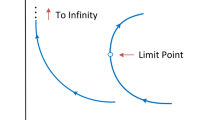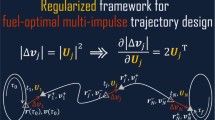Abstract
Laser Interferometer Space Antenna (LISA) is a project to detect and measure gravitational waves. The project has three spacecraft flying in a formation of near equilateral triangle in a heliocentric orbit trailing Earth. Many sources of perturbations cause the configuration to deviate from the nominal. This paper studies the formation design problem for a LISA-like mission by considering ephemeris-based dynamics. This type of mission is well-known for addressing several strict mission requirements under the realistic dynamics. The problem is formulated as optimizing multiple mission performance indices. It is observed that some indices are correlated with each other, whereas some indices have different sensitivities with respect to the semi-major axis. Therefore, the problem is transformed into a two-step cascade single-objective optimization, in which the optimal solution of the first optimization problem is fed to the second optimization as initial value. In addition, the major perturbing celestial bodies are picked up to make a simplified but accurate enough dynamics to speed up the optimization. Numerical examples verify the analysis and show the effectiveness of the optimization procedure. The influences of mission lifetime and spatial scales on the optimal solutions are also presented.
Similar content being viewed by others
Change history
11 February 2022
A Correction to this paper has been published: https://doi.org/10.1007/s42064-022-0136-2
References
Rowan, S., Hough, J. Gravitational wave detection by interferometry (ground and space). Living Reviews in Relativity, 2000, 3(1): 3.
Danzmann, K. LISA laser interferometer space antenna—a proposal in response to the ESA call for L3 mission concepts. Technical report, ESA, 2017.
Men, J. R., Ni, W. T., Wang, G. Design of ASTROD-GW orbit. Chinese Astronomy and Astrophysics, 2010, 34(4): 434–446.
Kawamura, S., Nakamura, T., Ando, M., Seto, N., Tsubono, K., Numata, K., Takahashi, R., Nagano, S., Ishikawa, T., Musha, M. et al. The Japanese space gravitational wave antenna-DECIGO. Classical and Quantum Gravity, 2006, 23(8): 125–131.
Gong, X. F., Lau, Y. K., Xu, S. N., Amaro-Seoane, P., Bai, S., Bian, X., Cao, Z. J., Chen, G. R., Chen, X., Ding, Y. W. et al. Descope of the ALIA mission. Journal of Physics: Conference Series, 2015, 610(1): 012011.
Luo, J., Chen, L. S., Duan, H. Z., Gong, Y. G., Hu, S., Ji, J. H., Liu, Q., Mei, J. W., Milyukov, V., Sazhin, M. et al. TianQin: a space-borne gravitational wave detector. Classical and Quantum Gravity, 2016, 33(3): 035010.
Diaz-Aguiló, M., Mateos, I., Ramos-Castro, J., Lobo, A., García-Berro, E. Design of the magnetic diagnostics unit onboard LISA pathfinder. Aerospace Science and Technology, 2013, 26(1): 53–59.
Trenkel, C., Kemble, S., Bevis, N., Magueijo, J. Testing modified newtonian dynamics with LISA pathfinder. Advances in Space Research, 2012, 50(11): 1570–1580.
Ziegler, T., Bergner, P., Hechenblaikner, G., Brandt, N., Fichter, W. Modeling and performance of contact-free discharge systems for space inertial sensors. IEEE Transactions on Aerospace and Electronic Systems, 2014, 50(2): 1493–1510.
Ni, W. T. Gravitational wave detection in space. International Journal of Modern Physics D, 2016, 25(14): 1630001.
ESA. The ESA-L3 gravitational wave mission — gravitational observatory advisory team — Final Report. Technical report, ESA, 2016.
Jennrich, O., Binétruy, P., Colpi, M., Danzmann, K., Jetzer, P., Lobo, A., Nelemans, G., Schutz, B. F., Stebbins, R., Sumner, T. et al. NGO: Revealing a hidden universe: opening a new chapter of discovery. Technical report ESA/SRE(2011)19, ESA, 2011.
Dhurandhar, S., Nayak, K. R., Koshti, S., Vinet, J. Y. Fundamentals of the LISA stable flight formation. Classical and Quantum Gravity, 2005, 22(3): 481–487.
De Marchi, F., Pucacco, G., Bassan, M. Optimizing the Earth-LISA ‘rendezvous’. Classical and Quantum Gravity, 2012, 29(3): 035009.
Alfriend, K. T., Vadali, S. R., Gurfil, P., How, J., Breger, L. S. Spacecraft formation flying: dynamics, control and navigation. Butterworth-Heinemann, 2009.
Nayak, K. R., Koshti, S., Dhurandhar, S. V., Vinet, J. Y. On the minimum flexing of LISA’s arms. Classical and Quantum Gravity, 2006, 23(5): 1763–1778.
Li, G. Y., Yi, Z. H., Heinzel, G., Rüdigger, A., Jennrich, O., Wang, L., Xia, Y., Zeng, F., Zhao, H. B. Methods for orbit optimization for the LISA gravitational wave observatory. International Journal of Modern Physics D, 2008, 17(7): 1021–1042.
Yi, Z. H., Li, G. Y., Heinzel, G., Rüdigger, A., Luo, Y. J., Xia, Y., Zhao, H. B. The Co-orbital restricted three-body problem and its application. Science China Physics, Mechanics and Astronomy, 2010, 53(1): 171–178.
Pucacco, G., Bassan, M., Visco, M. Autonomous perturbations of LISA orbits. Classical and Quantum Gravity, 2010, 27(23): 235001.
Cerdonio, M., De Marchi, F., De Pietri, R., Jetzer, P., Marzari, F., Mazzolo, G., Ortolan, A., Sereno, M. Modulation of LISA free-fall orbits due to the Earth-Moon system. Classical and Quantum Gravity, 2010, 27(16): 165007.
Hughes, S. P., Bauer, F. H. Preliminary optimal orbit design for the laser interferometer space antenna (LISA). Technical report, NASA, 2002.
Halloin, H. Optimizing orbits for (e)LISA. Journal of Physics: Conference Series, 2017, 840(1): 012048.
Walker, M. J. H., Ireland, B., Owens, J. A set modified equinoctial orbit elements. Celestial Mechanics and Dynamical Astronomy, 1985, 36(4): 409–419.
Gim, D. W., Alfriend, K. T. Satellite relative motion using differential equinoctial elements. Celestial Mechanics and Dynamical Astronomy, 2005, 92(4): 295–336.
Povoleri, A., Kemble, S. LISA orbits. AIP Conference Proceedings, 2006, 873: 702–706.
Giulicchi, L., Wu, S. F., Fenal, T. Attitude and orbit control systems for the LISA pathfinder mission. Aerospace Science and Technology, 2013, 24(1): 283–294.
Xia, Y., Li, G. Y., Heinzel, G., Rüdigger, A., Luo, Y. J. Orbit design for the laser interferometer space antenna (LISA). Science China Physics, Mechanics and Astronomy, 2010, 53(1): 179–186.
Gurfil, P. Relative motion between elliptic orbits: generalized boundedness conditions and optimal formationkeeping. Journal of Guidance, Control, and Dynamics, 2005, 28(4): 761–767.
Wang, G., Ni, W. T. Numerical simulation of time delay interferometry for new LISA, TAIJI and other LISA-like missions. arXiv:1707.09127, 2017.
Bik, J. J. C. M., Visser, P. N. A. M., Jennrich, O. LISA satellite formation control. Advances in Space Research, 2007, 40(1): 25–34.
Sweetser, T. H. An end-to-end trajectory description of the LISA mission. Classical and Quantum Gravity, 2005, 22(10): 429–435.
Merkowitz, S. M., Ahmad, A., Hyde, T. T., Sweetser, T., Ziemer, J., Conkey, S., Kelly III, W., Shirgur, B. LISA propulsion module separation study. Classical and Quantum Gravity, 2005, 22(10): 413–419.
Acknowledgements
The work was supported by the Hundred Talents Program of the Chinese Academy of Sciences and Strategic Priority Program A (Grant No. XDA15014902).
Author information
Authors and Affiliations
Corresponding author
Additional information
Chihang Yang is currently a Ph.D. student in Technology and Engineering Center for Space Utilization, Chinese Academy of Sciences. He received his B.S. degree in automation from Beijing Jiaotong University, China. His current research interests include dynamics, control and application of spacecraft relative motion, especially spacecraft formation flight and large-scale spacecraft swarms.
Hao Zhang received the B.S. and Ph.D. degrees in aerospace engineering from Beihang University, China, in 2006 and 2012, respectively. From 2012 to 2017, he was with the Asher Space Research Institute, Technion - Israel Institute of Technology, where he was a postdoctoral fellow. He is currently an associate research fellow with the Technology and Engineering Center for Space Utilization, Chinese Academy of Sciences, China. His research interests include distributed space systems, astrodynamics, and GN&C.
Rights and permissions
About this article
Cite this article
Yang, C., Zhang, H. Formation flight design for a LISA-like gravitational wave observatory via Cascade optimization. Astrodyn 3, 155–171 (2019). https://doi.org/10.1007/s42064-018-0042-9
Received:
Accepted:
Published:
Issue Date:
DOI: https://doi.org/10.1007/s42064-018-0042-9




